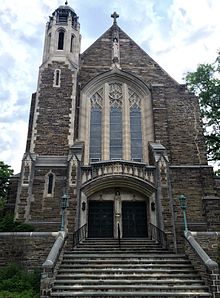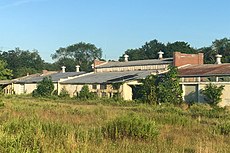Plainsboro
Plainsboro was incorporated as a township on May 6, 1919, from lands north of Plainsboro Road and Dey Road that had been part of South Brunswick and lands south of Plainsboro Road and Dey Road that had been part of Cranbury. The main impetus towards the creation of the township was the lack of schools serving the area; a new school was constructed after the township was established, which still exists as J.V.B. Wicoff School, named for one of the individuals who led the effort to create Plainsboro.
History
The original residents of Plainsboro were the Unami people, a subtribe of the Lenape Native Americans. In the 17th century, the Dutch settled the area for its agricultural properties.
The oldest developed section of Plainsboro is at the intersection of Dey and Plainsboro Roads. It is thought that the road was named after a Dutch-built tavern that sat at the intersection, called "The Planes Tavern," in the early 18th century or earlier. The building still stands and was featured on HGTV's If These Walls Could Talk along with the historic Plainsboro Inn building (circa 1790) that was built adjacent to "Planes Tavern" at Plainsboro Road and Dey Road.
In 1897, the Walker-Gordon Dairy Farm opened up, which, among many other things, contributed Elsie the Cow and The Walker Gordon Diner, which has since been closed. The site of the farm has been turned into a single-family home community named Walker-Gordon Farm, which consists of over 350 homes.
Other family farms arrived during the first three quarters of the 20th century, notably the Parker, Simonson, Stults, and Groendyke farms. The Parker Farm was eventually integrated into the Groendyke farm, and both became part of Walker-Gordon's Dairy Farm, which is now a housing development. The Simonson and Stults Farms still stand and operate in Plainsboro.

Plainsboro was officially founded on May 6, 1919, and was formed from sections of Cranbury and South Brunswick townships. Plainsboro Township was created in response to Cranbury and South Brunswick refusing to build a new fireproof and larger school in Plainsboro Village. Every year, the date is celebrated with a parade, festival, and a concert.
In 1971, Princeton University (which owned most of the township) and Lincoln Properties, Inc., together started to develop the area into what it is now, a large suburban township still holding on to its rural past. By the 1980s, Princeton University had acquired nearly 5,000 acres (2,000 ha) of Plainsboro Township, a holding far larger than the 4.5 acres (1.8 ha) size of the original university campus. In response to the development, West Windsor-Plainsboro High School South was opened in nearby Princeton Junction, then just called WWP High. To accommodate the additional growth, West Windsor-Plainsboro High School North was opened in Plainsboro in September 2000, beginning a north–south rivalry between the Pirates and the Knights.

The latest addition to Plainsboro is the Village Center, which is adjacent to the historic village area. Located at the intersection of Schalks Crossing and Scudder Mills Roads, Plainsboro Village Center currently features eight buildings totaling almost 75,000 square feet (7,000 m) of retail, commercial and office space, as well as 11 single-family homes and 12 townhomes. The Village Center contains wide landscaped sidewalks and outdoor, cafe'-style seating. The Village center's downtown atmosphere is the location of many shopping and dining destinations. The Village Center features a large village green with a tranquil fountain and walking paths in a park-like setting. The Village Center also houses a new $12.4 million Plainsboro Library, which opened on April 10, 2010. The township broke ground on July 27, for two new buildings that will host medical offices, additional retail space and eight residential condominium units.
A new hospital facility was under development in Plainsboro, that would be renamed University Medical Center of Princeton at Plainsboro. The new hospital and 171-acre (69 ha) medical campus was designed to include a modern medical office building attached to the hospital, a world-class education center, a health and fitness center, a skilled nursing facility, a pediatric services facility and a 32-acre (13 ha) public park. Officials at the Children's Hospital of Philadelphia (CHOP) announced they will be opening a facility in Plainsboro on 13 acres (5.3 ha) of the new hospital campus. Constructed at a cost of $523 million, the new hospital opened in May 2012, with patients relocated from the former facility in Princeton that had been in use for 93 years. The hospital was acquired in January 2018 by University of Pennsylvania Health System and renamed as Penn Medicine Princeton Medical Center.
Geography
According to the United States Census Bureau, the township had a total area of 12.11 square miles (31.37 km), including 11.74 square miles (30.40 km) of land and 0.37 square miles (0.97 km) of water (3.09%).
Plainsboro Center (with a 2010 Census population of 2,712) and Princeton Meadows (13,834 as of 2010) are unincorporated communities and census-designated places (CDPs) located within Plainsboro Township.
Other unincorporated communities, localities and place names located partially or completely within the township include Aqueduct, Schalks and Scotts Corner.
The township borders the municipalities of Cranbury and South Brunswick in Middlesex County; and East Windsor, Princeton and West Windsor in Mercer County.
Demographics
| Census | Pop. | Note | %± |
|---|---|---|---|
| 1920 | 460 | — | |
| 1930 | 1,018 | 121.3% | |
| 1940 | 925 | −9.1% | |
| 1950 | 1,112 | 20.2% | |
| 1960 | 1,171 | 5.3% | |
| 1970 | 1,648 | 40.7% | |
| 1980 | 5,605 | 240.1% | |
| 1990 | 14,213 | 153.6% | |
| 2000 | 20,215 | 42.2% | |
| 2010 | 22,999 | 13.8% | |
| 2020 | 24,084 | 4.7% | |
| 2023 (est.) | 23,874 | −0.9% | |
| U.S. Decennial Census 1920 1920–1930 1940–2000 2000 2010 2020 | |||
2020 Census
The 2020 United States census counted a total population of 24,084 people within Plainsboro Township, and 9,960 total households in the township. The median age of a Plainsboro resident was 38.2, while 22.2% of the population were under the age of 18. The racial makeup of the town was 13,596 (56%) Asian, 6,974 (28.9%) White, 1,646 (6.8%) Black/African American, 1,449 (6%) Hispanic/Latino, 71 (0.29%) American Indian and Alaska Native, 9 (0.037%) Native Hawaiian and Other Pacific Islander, 1,222 (5.07%) Mixed Race, and 566 (2.3%) were some other race.
Of 9,960 households, 56.9% were Married-couple family households, 20.5% were Female householder with no spouse present family households, and 18.2% were Male householder with no spouse present family households, with 4.6% being other means of living.
The Census Bureau's 2022 American Community Survey displays the median household income of the township was $120,971, with family households making $166,880 on average, with married/couple families making $173,910 on average, and nonfamily households making $84,755 on average.
2010 Census

The 2010 United States census counted 22,999 people, 9,402 households, and 5,886 families in the township. The population density was 1,951.6 per square mile (753.5/km). There were 10,089 housing units at an average density of 856.1 per square mile (330.5/km). The racial makeup was 41.07% (9,445) White, 8.03% (1,847) Black or African American, 0.30% (69) Native American, 46.22% (10,630) Asian, 0.02% (4) Pacific Islander, 1.76% (404) from other races, and 2.61% (600) from two or more races. Hispanic or Latino of any race were 6.21% (1,429) of the population. As of the 2010 Census, 29.6% of the township's population self-identified as being Indian American, making them the largest minority group in the township.
Of the 9,402 households, 36.5% had children under the age of 18; 53.4% were married couples living together; 7.0% had a female householder with no husband present and 37.4% were non-families. Of all households, 31.2% were made up of individuals and 3.8% had someone living alone who was 65 years of age or older. The average household size was 2.43 and the average family size was 3.14.
24.7% of the population were under the age of 18, 6.0% from 18 to 24, 35.7% from 25 to 44, 26.2% from 45 to 64, and 7.5% who were 65 years of age or older. The median age was 35.5 years. For every 100 females, the population had 98.8 males. For every 100 females ages 18 and older there were 96.4 males.
The Census Bureau's 2006–2010 American Community Survey showed that (in 2010 inflation-adjusted dollars) median household income was $86,986 (with a margin of error of +/− $5,536) and the median family income was $114,457 (+/− $6.162). Males had a median income of $76,846 (+/− $6,185) versus $58,515 (+/− $5,722) for females. The per capita income for the township was $46,222 (+/− $2,054). About 1.9% of families and 3.9% of the population were below the poverty line, including 3.6% of those under age 18 and 4.0% of those age 65 or over.
2000 Census
As of the 2000 United States census there were 20,215 people, 8,742 households, and 5,122 families residing in the township. The population density was 1,707.7 inhabitants per square mile (659.3/km). There were 9,133 housing units at an average density of 771.5 per square mile (297.9/km). The racial makeup of the township was 58.20% White, 7.58% African American, 0.10% Native American, 30.51% Asian, 0.01% Pacific Islander, 1.36% from other races, and 2.24% from two or more races. Hispanic or Latino of any race were 4.64% of the population.
As part of the 2000 Census, 16.97% of Plainsboro Township residents identified themselves as being Indian American. This was the second-highest percentage (behind Edison) of Indian American people in any municipality in the United States with 1,000 or more residents identifying their ancestry. In the 2000 census, 8.55% of Plainsboro Township's residents identified themselves as being of Chinese ancestry. This was the second-highest percentage (behind Holmdel Township) of people with Chinese ancestry in any municipality in New Jersey with 1,000 or more residents identifying their ancestry.
There were 8,742 households, out of which 33.4% had children under the age of 18 living with them, 50.4% were married couples living together, 6.4% had a female householder with no husband present, and 41.4% were non-families. 33.9% of all households were made up of individuals, and 2.2% had someone living alone who was 65 years of age or older. The average household size was 2.30 and the average family size was 3.06.
In the township the population was spread out, with 24.6% under the age of 18, 6.5% from 18 to 24, 45.2% from 25 to 44, 19.4% from 45 to 64, and 4.2% who were 65 years of age or older. The median age was 33 years. For every 100 females, there were 102.4 males. For every 100 females age 18 and over, there were 100.8 males.
The median income for a household in the township was $72,097, and the median income for a family was $88,783 (these figures had risen to $82,609 and $102,586 respectively as of the 2007 American Community Survey estimate). Males had a median income of $62,327 versus $44,671 for females. The per capita income for the township was $38,982. About 1.4% of families and 3.0% of the population were below the poverty line, including 1.7% of those under age 18 and 2.3% of those age 65 or over.
Economy

Forrestal Village is an upscale mixed use lifestyle center located on U.S. Route 1. The center opened in 1986 and has a gross leasable area of 720,000-square-foot (67,000 m), 52-acre (210,000 m) of retail and office space. It was designed by Sasaki Associates of Watertown, Massachusetts with the architectural firm Bower Lewis Thrower/Architects to "create a retail mix that will not just bring people in every few weeks like the regional malls do".
As of 2022 its tenants are primarily smaller boutique retailers, offices, restaurants, and a hotel. The center has also been approved for residential units. MarketFair in Princeton and Quaker Bridge Mall in Lawrence Township are also a short distance away.
Government
Local government

Plainsboro Township is governed by a Township Committee form of New Jersey municipal government. The township is one of 141 municipalities (of the 564) statewide governed under this form. The governing body is comprised of a five-member Township Committee whose members are chosen at-large on a partisan basis for three-year terms of office on a staggered basis, with either one or two seats up for vote each year as part of the November general election. Every January 1, the Township Committee re-organizes and selects a mayor and deputy mayor from among its membership. Township Committee meetings are open to the public and held on the second and fourth Wednesday of each month. A Township Administrator appointed by the Township Committee oversees Plainsboro's professional employees. Major departments are Administration, Township Clerk, Finance, Recreation/Cultural Affairs, Municipal Court, Public Safety, Public Works, Planning/Zoning, and Building Inspections, each overseen by a department head.
As of 2024, members of the Plainsboro Township Committee are Mayor Peter A. Cantu (D, term on committee ends December 31, 2026; terms as mayor ends 2024), Deputy Mayor Edward Yates (D, term on committee ends 2025; term as deputy mayor ends 2024), David Bander (D, 2025), Neil J. Lewis (D, 2024) and Nuran Nabi (D, 2024).






